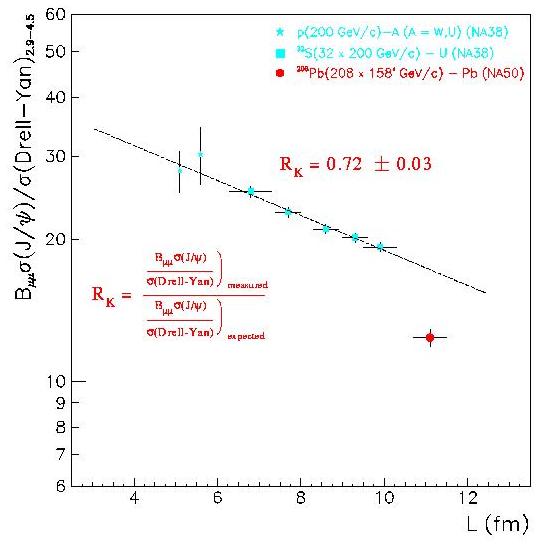The search for the quark-gluon plasma
is carried out at ultrarelativistic heavy-ion colliders
(in particular at the SPS at CERN:
NA35,
NA44,
NA45 (CERES),
NA50).
It will
enter a really hot phase
around 1999 at the RHIC
and a few years later at the
LHC by the
ALICE experiment.
A first piece of evidence for the
quark-gluon plasma might be the
anomalous J/psi suppression observed recently in Pb-Pb collisions
by NA50 at CERN:
This is a potential signature of a quark-gluon plasma, because
in the plasma the
(chromoelectric) Debye screening effect
cuts off the binding force between the constituent
charm and anticharm quarks
of J/psi.
 L is the mean length of the trajectory along which the
J/psi travels inside the nuclear matter (related, for a given reaction, to the impact parameter of the
collision). Error bars take into account both statistic and systematic effects.
Rk is the ratio between the measured (J/psi)/(Drell-Yan) cross sections ratio in NA50
experiment and the expected value obtained by using an absorption model. This expected value
comes from a fit using NA38 data. Rk is a quantitative estimate of the anomalous J/psi
suppression in Pb-Pb.
L is the mean length of the trajectory along which the
J/psi travels inside the nuclear matter (related, for a given reaction, to the impact parameter of the
collision). Error bars take into account both statistic and systematic effects.
Rk is the ratio between the measured (J/psi)/(Drell-Yan) cross sections ratio in NA50
experiment and the expected value obtained by using an absorption model. This expected value
comes from a fit using NA38 data. Rk is a quantitative estimate of the anomalous J/psi
suppression in Pb-Pb.
(More information can be found
here
or in the slides of
a talk by M. Gonin at ``Quark Matter 96''.)
Another recent interesting (i.e. not-yet-understood) signal from heavy-ion collisions has been
found by NA45 (CERES)
in S-Au collisions: ``Enhanced production of low mass electron pairs in 200-GeV/u S - Au collisions at the CERN SPS'' (CERN-PPE-95-26)

Anton Rebhan <rebhana@tph.tuwien.ac.at>
Page
last modified: May 22, 1996
 L is the mean length of the trajectory along which the
J/psi travels inside the nuclear matter (related, for a given reaction, to the impact parameter of the
collision). Error bars take into account both statistic and systematic effects.
Rk is the ratio between the measured (J/psi)/(Drell-Yan) cross sections ratio in NA50
experiment and the expected value obtained by using an absorption model. This expected value
comes from a fit using NA38 data. Rk is a quantitative estimate of the anomalous J/psi
suppression in Pb-Pb.
L is the mean length of the trajectory along which the
J/psi travels inside the nuclear matter (related, for a given reaction, to the impact parameter of the
collision). Error bars take into account both statistic and systematic effects.
Rk is the ratio between the measured (J/psi)/(Drell-Yan) cross sections ratio in NA50
experiment and the expected value obtained by using an absorption model. This expected value
comes from a fit using NA38 data. Rk is a quantitative estimate of the anomalous J/psi
suppression in Pb-Pb.
